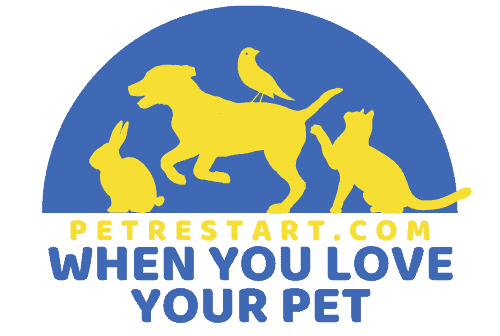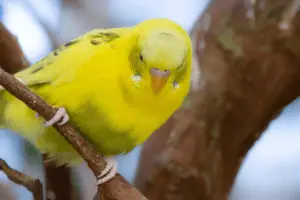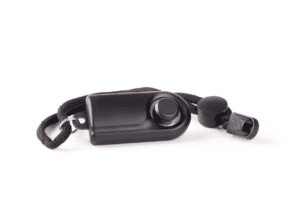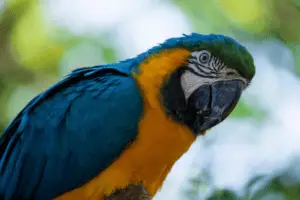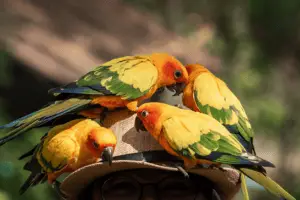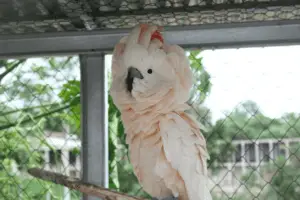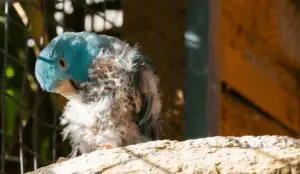Like our skin, feathers are essential to a bird’s body and lifestyle. Besides helping them stand out among other species, the feathers help birds stay warm and dry, especially during the cold season.
Feathers protect them from predators, so what do you think will happen to your bird when its feathers get damaged? Can my bird regrow new feathers?
All birds lose their feathers at some point; in fact, they undergo a process known as molting. Luckily, they can regrow feathers even when damaged. Most birds can take up to 12 months to regrow the damaged feathers, but some birds cannot regrow their wing feathers.
Despite being the most crucial part of their bodies, birds eventually lose their feathers. They may lose them while fighting a predator or due to an illness. Birds also lose their feathers through molting and can pluck them off when stressed.
In this article, we’ll answer the question, “Do bird feathers grow back? We’ll also show you how long it takes for the feathers to grow and if every bird can regrow their wing feathers.
So let’s dive right in.
Do Bird Feathers Grow Back?
Yes, most bird species can regrow their feathers. They’re crucial for camouflage, insulation, and flight. Male birds use them during the communication and courtship process. Therefore, they spend considerable time caring for their feathers; their lives depend on them.
So they bathe, dust, and preen their feathers; they perform several care operations to look stunning. Unfortunately, they can’t stop the feathers from wearing out.
Like human hair or nails, feathers consist mainly of keratin protein and are considered “dead” structures. Consequently, they cannot regenerate themselves if damaged and must be entirely replaced, according to all about birds.
Replacing some or all of the feathers is known as molting. Molting results in a new set of healthy feathers and potentially modifies the bird’s appearance, such as introducing new colors or patterns that can convey information about the bird’s age, gender, or the time of the year.
Why Do Birds Lose Their Feathers?
Birds tend to lose feathers for a couple of reasons. Some reasons may be typical, like molting, a natural process. But there are other reasons why birds lose their beautiful feathers; some of these reasons include:
- Losing feathers via molting: every bird undergoes this process once or twice yearly. The molting process can vary with bird species, particularly those in captivity that stay indoors where daylighting is irregular. When the process is about to start, your bird can become stressed and frightened with the feathers falling off. But we’ll elaborate more on molting later.
- Stress can force your bird to start a destructive behavior, including plucking its feathers. Your bird’s stress comes from a change in its usual routine, poor living conditions, lack of socialization, and being intimidated by a dominant cage mate. Depression has forced some birds to start self-mutilating, removing some of their primary feathers.
- Bacteria and viruses can cause your bird to lose its feathers. The most common one affecting birds like ducks and pigeons is Circovirus. This virus causes the loss of feathers on the bird’s head. Polyomavirus is also associated with feather loss.
- Excessive grooming by the other birds in its cage: excessive grooming can result in your bird losing some of its feathers. Feather plucking by family members can also result in the loss of feathers.
What Is Molting?
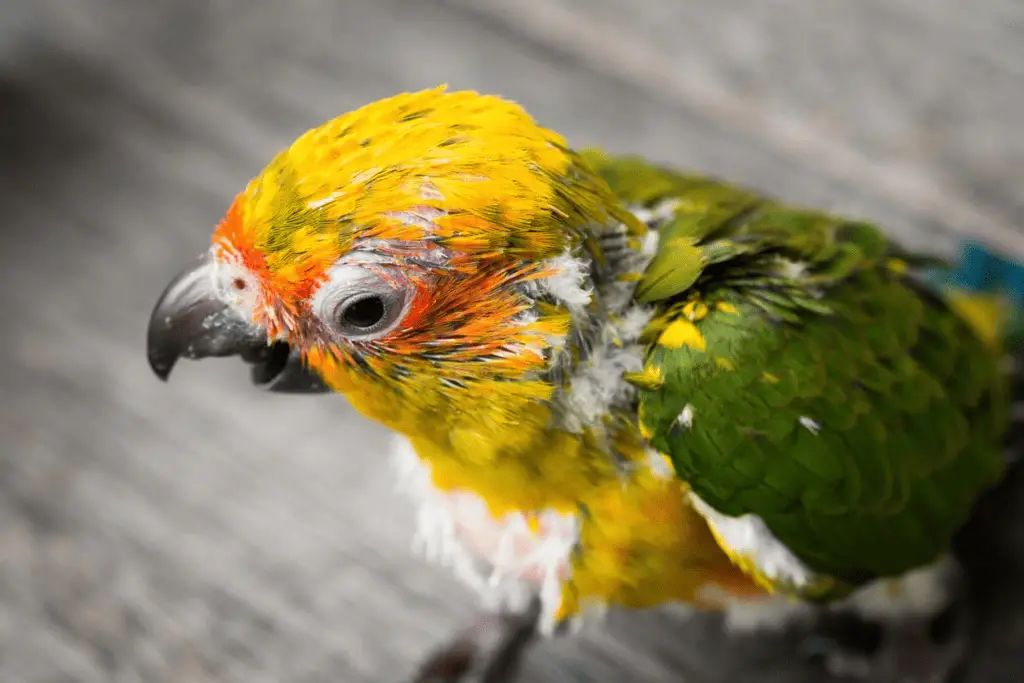
Molting, also called shedding or sloughing, is a natural process by which animals, including birds, cast off the outer layer of their body. In the case of birds, it’s the process of shedding and regrowing all or part of their feathers, according to Wikipedia.
Every bird molts; they shed their weathered, old feathers for some new ones. According to the North Dakota state government, some species are known for molting once yearly, while others do it twice or thrice annually. Some species, like the waterfowl, lose all their feathers at once and remain flightless for up to 4 weeks.
The black terns undergo a complex molting cycle that starts when their eggs hatch in June. Unfortunately, they can’t afford to remain flightless for an extended period; therefore, their molting process is over a very long time. But most adult birds shed their feathers in the breeding season as they prepare for the winter.
How Do They Molt?
Generally, bird’s feathers tend to wear out due to the following reasons:
- Rubbing against trees or other feathers,
- Flying,
- Exposure to the sun,
- Parasites can end up damaging the feathers. The pigmented feathers tend to wear out faster than the white ones.
Feathers are known for growing from the skin follicles; therefore, the growth of the new feathers from the follicles tends to push the older ones out. The molting process is a gradual one, and it can take place in sequences on the bird’s skin, which will guarantee that there are no bald patches.
Therefore, a complete molt can be spread over a certain period, which is fine if it’s not a migrant and has a vast food supply.
Minute birds tend to molt over five weeks; fortunately, the feathers of migratory birds grow faster. The molting pattern will depend on age, time, and species, but this process has three molting periods.
How Does Losing Feathers Affect The Life Of Our Birds?
Generally, the entire process takes lots of energy to regrow its feathers. Your bird may lose heat when it sheds its feathers, affecting its insulation. Plus, they will need more energy to keep warm and even fly when featherless.
Molting is the real reason most birds become vulnerable to predation in the wild. Luckily it doesn’t overlap with most processes like migration and breeding.
Like most birds, swans, geese, and ducks lose their flight at once during molting. Male ducks shed the colored feathers and replace them with brown. After the flight, feathers regrow, and the molting process begins again. The female ducks lose their feathers after their young ones have become independent.
How Long Will The Feathers Take To Grow After Molting?
As aforementioned, the molting feathers fall out due to the healthy and vibrant feathers that are already growing. But how can you tell if the loss of a feather is due to molting and not plucking?
Well, the best way is to examine your bird’s body. Simply look at its entire body for some bald patches. These patches under the wings are the best sign of molting.
Another method of confirming if it’s molting and not plucking is by examining the feathers in the cage. If you find a feather that looks bitten off, your bird is plucking them. Either way, these feathers do grow back with time.
Fortunately, the time it takes for the feather to regrow depends on several factors, including climate, the extent of the damage, and the type of bird. But in general, it takes between 1 to 12 months for the feathers to grow back. However, some birds molt their feathers in a phase lasting up to a year.
Generally, the regrowing process begins with the feathers developing in their follicles. Follicles are tiny sacs containing cells that form into new feathers. After the follicles have developed, the new feathers can start growing slowly before picking up as the feathers mature.
Can My Bird Regrow Wings?

Generally, birds can regrow all their feathers, except the wings, which can take longer or not grow back in some birds. For instance, if its wing is severed, it won’t regrow.
If the feathers are damaged, then they can grow back with time. Remember, the feathers do grow back after the molting process. But do all feathers grow back after being plucked? The answer is yes, but it will depend on the level of damage made and your bird’s diet.
Can My Bird Regrow Its Primary Feathers?
Your bird can regrow their primary feathers, but their duration varies with bird species. For instance, raptors can take up to a year to regrow their primary feathers, while songbirds can take 6 to 12 months.
Unfortunately, for some species, the primaries may not regrow properly. They may be shorter than initially, but they will be adequate for flying around.
Can My Bird Regrow Its Flight Feathers?
Yes, most bird species can regrow their flight feathers. These feathers are crucial for your bird’s ability to fly around. They can lift our birds while helping them steer around while looking for food. Our feathery pals lose their flight feathers; fortunately, they grow back quickly.
The new flight feathers can be flexible and soft but harden, mature, and become more aerodynamic with time.
Can My Bird Regrow Clipped Feathers?
Your bird can quickly regrow all the clipped feathers. Generally, a feather is dead tissue; therefore, the feathers will grow back as long as the follicles are not damaged.
If it’s okay, a new feather will replace it within a few weeks. But the process of regrowing these feathers varies with species.
For example, parakeets can regrow their feathers within weeks, but pigeons can take months. But the rate at which a bird regrows its feathers depends on hydration and proper nutrition. And if you’re the one plucking the feathers, you have to be careful not to damage the follicles.
How Can I Help My Bird’s Feather Regrow?
The regrowing process can be nutritionally taxing to your pet’s body. So if you want your pet to have some healthy and vibrant feathers, you should learn more about the many parrot wellness strategies.
Bird wellness care refers to how to take care of an exotic bird. After all, a bird getting its emotional and physical needs taken care of doesn’t need to pluck its feathers.
This strategy goes a long way to guarantee that your bird has beautiful and healthy feathers. Some of the crucial wellness things to do include:
Pain Prevention And Preventive Health Care
Proper health care is crucial since our pets hide pain, injuries, and illnesses. Therefore, you should take your pet for its annual checkup, which can help you detect any disease early.
Enrichment
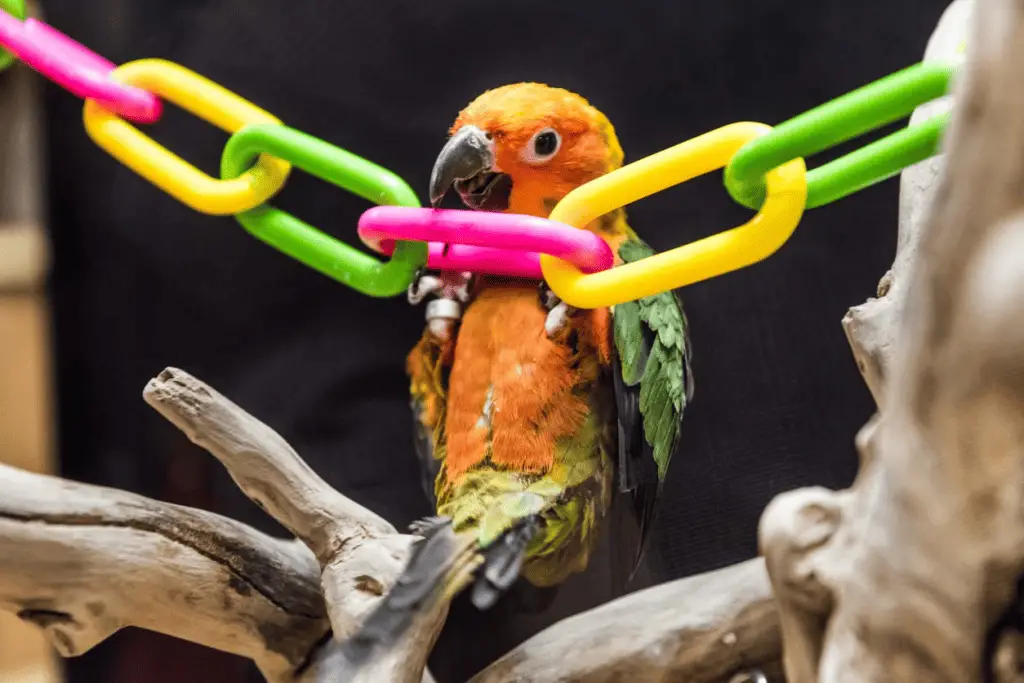
Enrichment includes stimulating your bird’s senses. You can divide this into tactile, auditory, olfactory, and visual enrichment. For instance, giving it toys, putting the TV on when away, and doing puzzles can keep your bird busy enough to pluck its feathers.
Behavior Training
You can teach your bird crucial behaviors like foraging, eating veggies, and correctly grooming its feathers. With proper grooming techniques, you’ll never have to worry about your pet plucking its feathers.
A well-trained bird can be a more emotionally content bird. Clicker training can come in handy in these situations.
Nutrition
A proper diet is mandatory for any bird’s health; the healthier it is, the better its chances of fighting off several ailments. So it would help if you taught your bird to consume several foods.
But most importantly, you should teach your pet to consume the right food. And with delicious veggies, you should teach them what to eat, which means placing some food in front of it and convincing it to eat.
So make sure you give it food rich in vitamin D. Exposure to sunlight will help your bird synthesize vitamin D, which is crucial for proper feather development. So if the cause of the issue is a poor diet, you should improve your diet.
It means providing them with the right minerals and vitamins. Besides vitamin D, you must feed your bird food rich in vitamins A and E. Vitamin A plays a significant role in keratin production, an essential protein for making feathers.
Vitamin E protects the feathers from all the damage triggered by free radicals. On the other hand, vitamin D will help your bird absorb calcium which is necessary for healthy feathers and bones.
Why Won’t My Bird’s Feathers Regrow?
Unfortunately, our bird’s feathers don’t always grow the usual way; some never grow back. After all, viral and bacterial infections can leave your pet with permanent damage. Some dangerous conditions like kidney and liver illnesses can trigger further permanent feather loss.
Another reason your bird’s feathers won’t grow back is damaged feather follicles. If your bird loves plucking its feathers and has done so for a very long period, it can damage the follicles. Therefore, you must find out the leading cause of the problem before it results in severe damage.
Can Our Birds Live Without Feathers?
Birds can live without feathers in summer but won’t fly well or survive the cold months. Without its feathers, finding food in the wild can be challenging; plus, they’re susceptible to predators.
After all, without their feathers, their bodies become exposed to a wide range of parasites. Feathers help them hide from their predators, so when featherless, predators can easily spot them and attack.
Remember, feathers have several functions, including:
- Insulation
- Communication
- Camouflage: they help our birds protect themselves from predators.
Luckily, these birds can still fly even when they have bald patches all over their bodies. They can still fly even with small-sized feathers.
Why Do Birds Pluck The Feathers Of Their Babies?
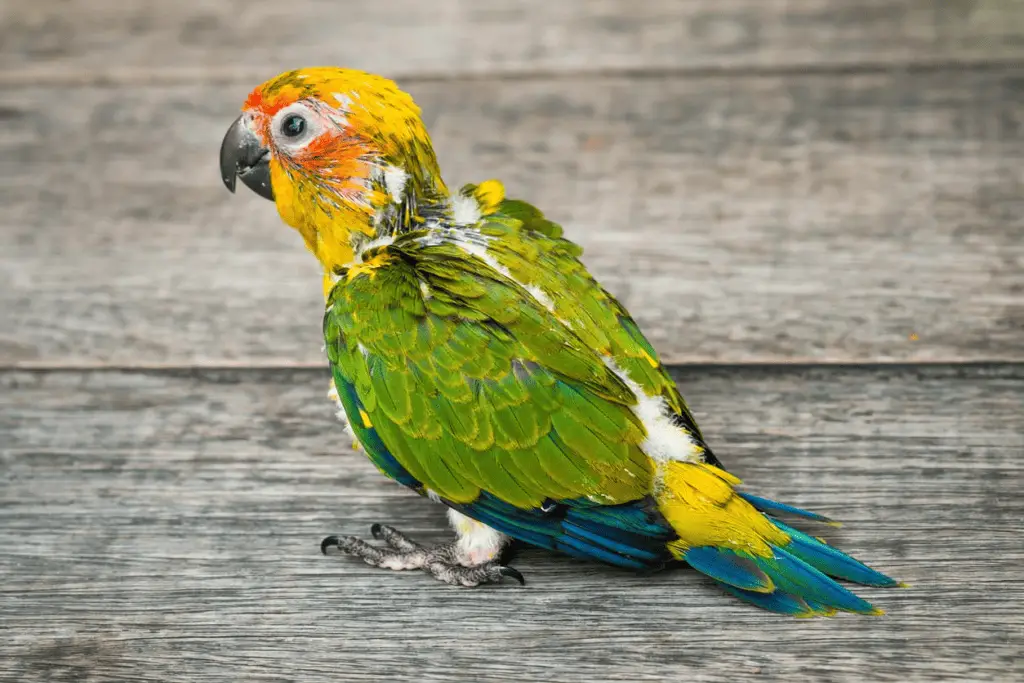
Female birds pluck the feathers of their babies over the years for several reasons. First and foremost, they need the babies out of the nests so that they can begin laying other eggs. Another reason is that parasites attack their chicks. If parasites are the problem, the parents can remove them by plucking their baby’s feathers.
Conclusion
Like most animals, birds have been known for shedding the external layer; in our case, it’s the feathers. Every bird species does molt at some point every year, which is a normal process. Unfortunately, birds pluck their worn-out feathers when depressed, a process known as self-mutilation.
Luckily, these birds can regrow the plucked feathers within 6 to 12 months. But the time it takes for the feathers to regrow varies with the bird species. Birds of prey are known to take longer, while birds like the lovebird take an even shorter time.
Luckily, you can help boost the process of regrowing their feathers in many ways. For instance, proper nutrition can increase the regrowing process, and within the shortest time possible, your bird will return to normal.
- Molting, https://web.stanford.edu/group/stanfordbirds/text/essays/Molting.html/ Accessed April 24, 2023
- All About Birds’ staff, The basics: feather molt, https://www.allaboutbirds.org/news/the-basics-feather-molt/#/ Accessed April 24, 2023
- Wikipedia contributors, Circovirus, https://en.wikipedia.org/wiki/Circovirus/ Accessed April 24, 2023
- Wikipedia contributors, Moulting, https://en.wikipedia.org/wiki/Moulting/ Accessed April 24, 2023
- Molting, https://gf.nd.gov/wildlife-notes/molting/ Accessed April 24, 2023
- YouTube contributors, nine ways to get a pet bird to eat veggies, https://www.youtube.com/watch?v=15hD13AhE70&embeds_euri=https%3A%2F%2Fbirdsupplies.com%2F&feature=emb_imp_woyt/ Accessed April 24, 2023
